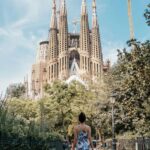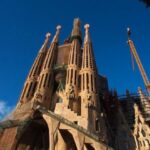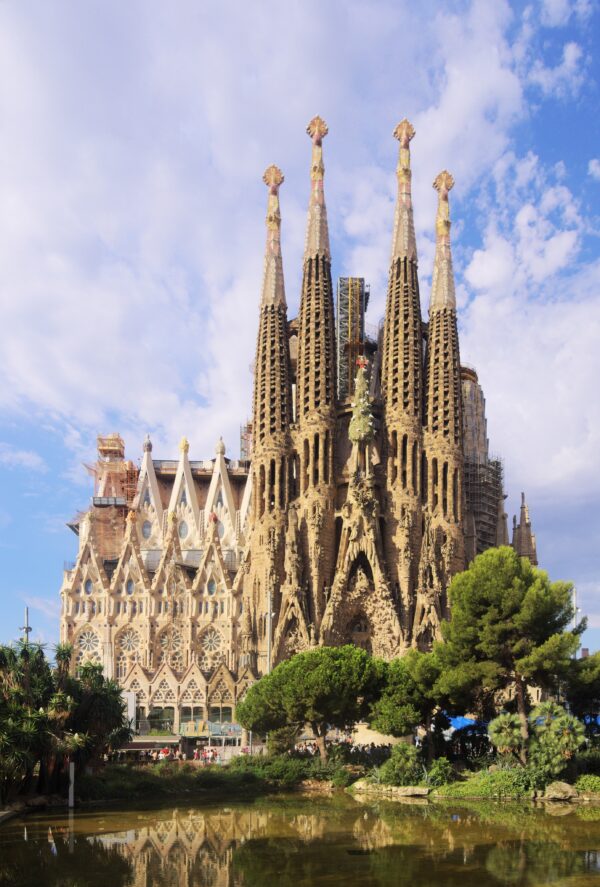
The Sagrada Familia, an iconic masterpiece by Antoni Gaudí, stands as a testament to architectural innovation and artistic vision. This basilica, still under construction since its inception in 1882, captivates millions of visitors each year with its intricate details and spiritual ambiance.
In this guide, we delve into the heart of this architectural marvel. With our insights in Unveiling the Splendor: Sagrada Familia in Barcelona – All You Need to Know, you will discover everything you need to appreciate its grandeur, history, and the ongoing journey of its creation.
Exploring the Architectural Marvel of Sagrada Familia in Barcelona
The Sagrada Familia is not just a church; it is a symbol of creativity and dedication. Designed by Antoni Gaudí, its unique blend of Gothic and Art Nouveau styles creates a breathtaking visual experience. Visitors are drawn not only to the structure itself but also to the profound spiritual atmosphere that envelops the basilica.
As you explore the Sagrada Familia, you will encounter a myriad of architectural elements that showcase Gaudí's genius. Key features include:
- Intricate Facades: Each facade tells a different story, from the Nativity to the Passion.
- Natural Forms: The design incorporates organic shapes that mimic nature, enhancing its beauty.
- Colorful Stained Glass: These windows fill the interior with a mesmerizing spectrum of light.
One of the most remarkable aspects of the Sagrada Familia is its ongoing construction, which reflects the evolving understanding of engineering and design. With an expected completion date in the next few decades, it serves as a living project that continues to inspire architects worldwide. The integration of modern technology with traditional craftsmanship is a testament to its timeless appeal.
Visitors can appreciate the significance of the Sagrada Familia not only through its aesthetic attributes but also through its cultural impact. It is a UNESCO World Heritage site, recognized for its universal value, and stands as a beacon of faith and artistic brilliance. Whether you are an art enthusiast or a curious traveler, the journey through this architectural marvel is sure to leave a lasting impression.
The Rich History Behind Gaudí's Sagrada Familia: A Cultural Icon
The history of the Sagrada Familia is as intricate as its architectural design. Initiated in 1882, the basilica was originally planned by Francisco de Paula del Villar, but Antoni Gaudí took over the project a year later. His vision transformed the church into a unique fusion of Gothic and Art Nouveau, reflecting both his innovative spirit and deep religious devotion.
Throughout its construction, the Sagrada Familia has faced numerous challenges, including the Spanish Civil War, which halted work for several years. Despite these setbacks, the project has continued to progress, with Gaudí dedicating the last 15 years of his life entirely to its construction. Today, it stands as a powerful symbol of perseverance and faith, embodying the artist's unwavering commitment to his work.
The basilica's influence extends beyond architecture; it has become a cultural icon for the city of Barcelona. Visitors from around the globe flock to witness its beauty, making it one of the most visited monuments in Spain. The Sagrada Familia serves not only as a church but also as a gathering place for art lovers, pilgrims, and tourists alike, fostering a sense of community and shared appreciation for Gaudí's genius.
In summary, the Sagrada Familia represents a rich tapestry of history, art, and spirituality. Its ongoing construction, coupled with Gaudí's visionary designs, ensures that this cultural landmark will continue to inspire generations to come. As work progresses towards anticipated completion, this architectural masterpiece remains a testament to the enduring power of human creativity.
Top Tips for Visiting Sagrada Familia: Your Ultimate Guide
When planning your visit to the Sagrada Familia, it's essential to book your tickets in advance to avoid long lines. Online tickets often allow you to select your preferred time slot, ensuring a smoother entry. Make sure to visit during the evening golden hour for a magical experience as the sunlight enhances the basilica's colors.
Consider joining a guided tour to gain deeper insights into the architecture and history of this iconic structure. Knowledgeable guides can offer fascinating stories about Gaudí's vision and the ongoing construction efforts. Additionally, look for audio guides that allow you to explore at your own pace while still receiving important details.
To enhance your experience, be mindful of the following tips:
- Dress Code: As a place of worship, modest clothing is encouraged. Ensure that shoulders and knees are covered.
- Photography: While photos are allowed, be respectful of other visitors and the sacred atmosphere.
- Accessibility: The basilica is wheelchair-friendly, with ramps and elevators available for ease of movement.
Lastly, don't forget to take time to explore the surrounding area. Nearby parks and viewpoints offer stunning perspectives of the Sagrada Familia, perfect for those memorable photos. The vibrant neighborhood also boasts a variety of cafes and shops, ideal for a post-visit refreshment or souvenir shopping.
Discover the Symbolism of Sagrada Familia's Unique Design Elements
The Sagrada Familia's design is deeply woven with symbolism, reflecting spiritual narratives and the natural world. Each element serves a purpose beyond mere aesthetics, inviting visitors to explore its rich meanings. For instance, the three grand façades—Nativity, Passion, and Glory—each represent different facets of Christ's life, encapsulating the essence of the Christian faith.
Moreover, Gaudí's use of natural forms in the basilica's structure pays homage to the environment. The columns resemble trees, branching out to support the roof, creating a forest-like interior that connects visitors with nature. This aspect underscores Gaudí's belief that architecture should harmonize with the natural world, further enhancing the spiritual experience.
The intricate stained glass windows are another remarkable design element, designed to fill the interior with a spectrum of colors that change throughout the day. This dynamic play of light symbolizes the presence of the divine, transforming the atmosphere within the basilica. Visitors often remark on how the light interacts with the space, creating a sense of peace and introspection.
Finally, the overall structure of the Sagrada Familia is intended to represent the Holy Family, with the towering spires symbolizing the skies reaching towards the heavens. This ambitious design serves not only as a physical representation of faith but also as a reminder of the aspirations of humanity to connect with the divine, making every visit a profound journey of discovery.
The Stunning Interior of Sagrada Familia: What to Expect Inside
The interior of the Sagrada Familia is nothing short of breathtaking, inviting visitors to embark on a sensory journey through Gaudí's imaginative vision. Upon entering, you will be greeted by towering columns that resemble trees, creating an enchanting forest-like atmosphere. This design not only showcases Gaudí's genius but also symbolizes a deep connection to nature, allowing visitors to feel a sense of tranquility and reverence.
One of the standout features of the basilica's interior is its stunning stained glass windows, which bathe the space in a kaleidoscope of colors. As sunlight filters through, it transforms the interior into a vibrant spectacle, enhancing the spiritual ambiance. Each window tells a story and is masterfully designed to evoke various emotions, guiding visitors through a visual narrative of faith and beauty.
Additionally, the intricate details of the interior, from the meticulously carved altarpieces to the unique lighting fixtures, contribute to the overall aesthetic experience. Visitors will find themselves immersed in a world where every corner reveals a new artistic element. The interplay of light and shadow creates a dynamic environment, making each visit to the Sagrada Familia uniquely captivating.
To fully appreciate the interior's grandeur, take your time exploring the various chapels and altars, each adorned with symbolic elements reflecting the Christian faith. The Holy Family is represented throughout, emphasizing the basilica's purpose as a place of worship. Whether you're a first-time visitor or returning to admire its evolving beauty, the interior of the Sagrada Familia promises an unforgettable experience steeped in spirituality and artistry.
Sagrada Familia Opening Hours and Ticket Information: Plan Your Visit
Planning your visit to the Sagrada Familia requires some foresight, especially regarding opening hours. The basilica is typically open to visitors from 9:00 AM to 8:00 PM during the summer months and from 9:00 AM to 6:00 PM during winter. It's advisable to check the official website for any special holiday hours or changes due to ongoing construction work.
When it comes to ticket information, purchasing in advance is highly recommended to avoid long queues. Tickets can be bought online, where you can select your preferred date and time. Here’s a quick overview of ticket options:
| Ticket Type | Price | Access |
|---|---|---|
| Basic Entry | €26 | Access to the basilica |
| Audio Guide | €30 | Includes basic entry and audio guide |
| Guided Tour | €45 | Includes entry with a guided tour |
Additionally, consider visiting during off-peak hours for a more serene experience. Early mornings or late afternoons tend to be less crowded, allowing you to fully immerse yourself in the beauty of this architectural wonder. As a final tip, always check for any special events or temporary exhibitions that might enhance your visit to the Sagrada Familia.
 The Majestic Sagrada Familia: Exploring Barcelona's Architectural Marvel
The Majestic Sagrada Familia: Exploring Barcelona's Architectural Marvel Unveiling the Wonders Inside Barcelona's Sagrada Familia: A Journey Through Architectural Marvels
Unveiling the Wonders Inside Barcelona's Sagrada Familia: A Journey Through Architectural Marvels The Majestic Beauty of Sagrada Familia: Explore Barcelona's Official Website
The Majestic Beauty of Sagrada Familia: Explore Barcelona's Official WebsiteIf you want to know other articles similar to Unveiling the Splendor: Sagrada Familia in Barcelona – All You Need to Know you can visit the category WHERE YOU CAN GO.
Leave a Reply










Read more!